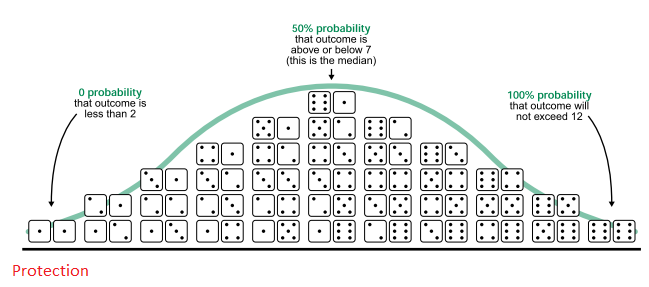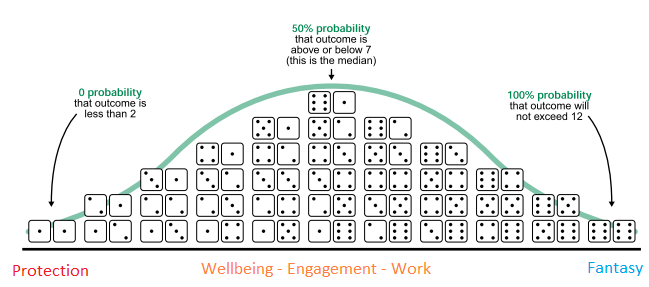Unveiled: Protection’s Big Issue

Lack of customer engagement has long posed a challenge for individual protection insurers.
Societal non-engagement with the risks covered by protection products directly reduces the likelihood of buying cover. For those who do buy, lack of ongoing interest increases the chances of lapse. In combination we have Swiss Re’s decades-old protection gap.
Where this article fits
This engagement article suggests there is a major problem with lack of engagement of potential and actual customers with protection. We explain why the current protection offering and thinking means non-engagement is inevitable – almost mathematically so.
| Protection 3.0 | ||
| Membership | Engagement | Wellbeing |
The membership article argues that the nature of mutual membership should be reviewed. We suggest an enhanced membership offering would appeal to a wider demographic, foster long-term engagement and differentiate mutual versus proprietary insurers.
This wellbeing article suggests one solution. A comprehensive wellbeing proposition has engagement designed in from outset. The real question: will protection insurers be involved?
The Protection 3.0 article brings everything together into a people-centred insurer proposition.
Non-engagement: underlying causes
Despite the crucial nature of protection products, a significant proportion of the population remains disengaged. Why?
At the heart of the matter lies a fundamental paradox: the events these protection products guard against are statistically improbable and emotionally distressing. This dual nature creates a barrier to engagement that is built into the fabric of the protection industry.
Life as a game of dice
Our common experience that good and bad things happen in life. Great and terrible things seem quite rare: life is mostly lived between these extremes.

A double one, on the left represents the “bad things” against which insurers provide financial cover.
Probability
For any given individual the likelihood of experiencing a critical illness or death over a specific time period is relatively low, either in actuality or perception.
Rather than preparing for such eventualities, customers may perceive protection products as unnecessary or low-priority expenses.
Especially given the distant and abstract nature of rare or unlikely events, probability neglect, a cognitive bias, can lead individuals to underestimate the importance of protection products and to prioritize more immediate concerns in their financial planning.
Psychology
The thought of facing a critical illness or the loss of a loved one is inherently uncomfortable and anxiety-inducing. As human beings, we have a natural tendency to avoid thinking about unpleasant outcomes, a phenomenon known as cognitive avoidance.
Reluctance to contemplate worst-case scenarios can result in procrastination or avoidance when purchasing or reviewing protection products.
Rather than confronting the possibility of adversity head-on, many individuals prefer to push these thoughts aside and focus on more positive aspects of life.
“The more serious the threat and the more emotional the topic the less reassuring a reduction in risk seems to us.” Source: Rolf Dobelli: The Art of Thinking Clearly
So what?
Non-engagement with protection products is almost inevitable. It is rooted in a combination of statistical improbability and psychological aversion. Recognizing and addressing these barriers is essential for insurance providers seeking to foster greater customer engagement.
But how do we actually do this? We’ll look at three things we’ve tried and suggest a more radical alternative, to get to the cause of non-engagement.
Current attempts to boost engagement
Today’s efforts to increase engagement come from:
- advisers: through education and better sales techniques
- providers: better processes and added value services
Advisers
With their expertise and holistic approach to financial planning, advisers can can help clients navigate the complexities of protection products, explaining their importance and the potential risks they mitigate. Advice can be personalized to individuals’ specific needs and circumstances.
Some advisers provide ongoing support and proactive reviews, to reinforce the value of the protection provided and reminding clients of the importance of staying adequately insured.
Some advisers suggest that, for IP especially, increasing sales starts with education, both of advisers(!) and, more obviously, consumers:
Increasing sales starts with education. Ultimately, it would be great to reach out to the population at large to offer some reality checks and demonstrate the need for, and value of, protecting your income, but that’s a tall order, or at the very least a goal we must take small steps to achieve over time. Matthew Chapman: Why we still need to talk about IP
Adviser articles and insurer sales aids offer techniques e.g. stories, objection handling and statistics. Advisers are savvy, doing what’s best for their business and clients. Better conversations and techniques will help directionally.
But it’s still push marketing.
“General insurance protects against the everyday. Our product is best understood as catastrophe insurance: consumers generally buy it reluctantly and begrudgingly.”
Source: Lifesearch report
The grudge overcomes logic, working against us and against greater protection sales.
Great advice and techniques have to be a good thing, and that’s what advisers can affect. It seems to be working for IP but this won’t give transformation. The inherent challenges of statistical improbability and psychological aversion to contemplating unpleasant outcomes remain.
The solution goes beyond advice. We need to grow the pie.
Technology
Leveraging technology to streamline the purchasing process and provide personalized recommendations can help overcome inertia and make it easier for customers to take action. That has largely been done over the last 20 years, as part of Protection 2.0: getting to scale.
Technology and health
Now common, added value benefits seem attractive to customers and are emphasized by insurers. As an example, Teladoc provides AIG’s Smart Health:

Insurers are charged on an assumed customer take up rate, which seems to be increasing rapidly: Aviva reports app registrations jumped by almost 150% over 2023.
The Exeter says 63% of usage of their Healthwise app is attributable to remote GP appointments. With their app use also increasing by 131% perhaps advisers are right to question the long-term, financial sustainability. Will others move closer to the L&G approach to added value benefits?
L&G’s core wellbeing support from RedArc nurses is free with one of their protection products. L&G’s separate GP24 service, provided by Healix costs £3.25 per month. (Aside: MetLife’s GP24 service is free to customers and is supplied by HealthHero.)
The real question: is this true ongoing engagement? I think not; it is someone (e.g.) suffering anxiety, feeling unwell or not being able to get a timely GP appointment and realising that someone has provided them with a free and convenient solution.
Result: no engagement without a problem.
Engagement refers to the level of involvement, interaction, or connection that individuals have with an activity, product, or content. It measures someone’s attention, interest, or emotional investment. Source: ChatGPT
Does it sound like we’ve nailed engagement with anything above?
Engagement: a radical alternative
Back to the original graphic. Recall that non-engagement with protection was an inevitable consequence of focusing on low probability “bad things which might happen”.
What if we could just move along to the right of the curve? Again, inevitably, this is where most of life takes place.

What if protection were more like this?
Instead of thinking about only downside health-related events and providing financial protection against them, what if we were a little more creative? We can and should think bigger.
We could give more weight to mental health. Then the whole of health, not just downside. Then the whole of wellbeing, beyond health – what people are really engaged with.
But that’s not protection!
Admittedly a lot of this could be done in the absence of any protection product or sale. Nonetheless, some are thinking widely. PwC suggests that:
… health insurers’ roles shift from sellers of insurance products to active health advisors. A core digital platform measures, maintains, and improves quality of health throughout the lifespan of a customer journey. Source: PwC’s Health Insurer of the Future
Some have already moved. For years Vitality’s shared value insurance has been encouraging people to make healthier choices a habit and shift behaviors associated with better health.
But even with Vitality we’re still emphasizing physical health. The consumer offer is also relatively expensive for the insurer, with knock-on price effects.
The opportunity
Health insurers are able to position themselves as fully integrated health and wellness companies, creating an all-encompassing engagement beyond the risk cover.
Source: PwC’s Health Insurer of the Future
Good though they are, the PwC and Vitality health emphasis can be expanded to something more popular and more engaging.